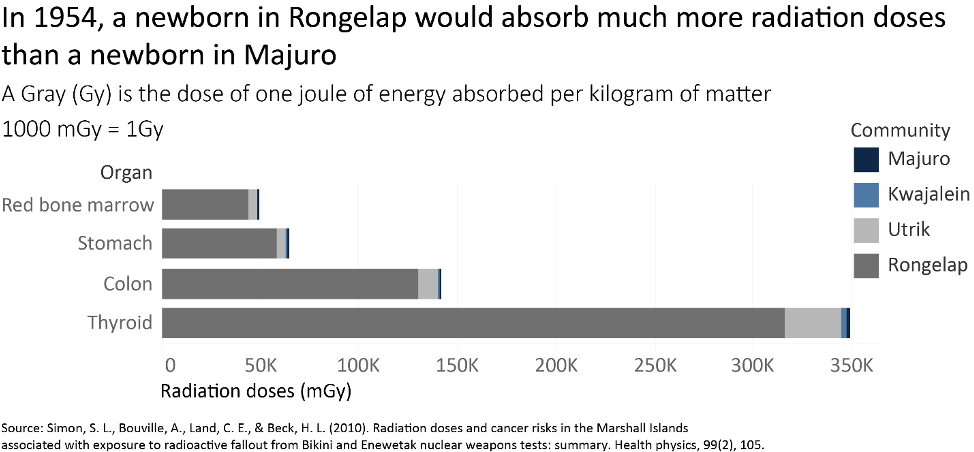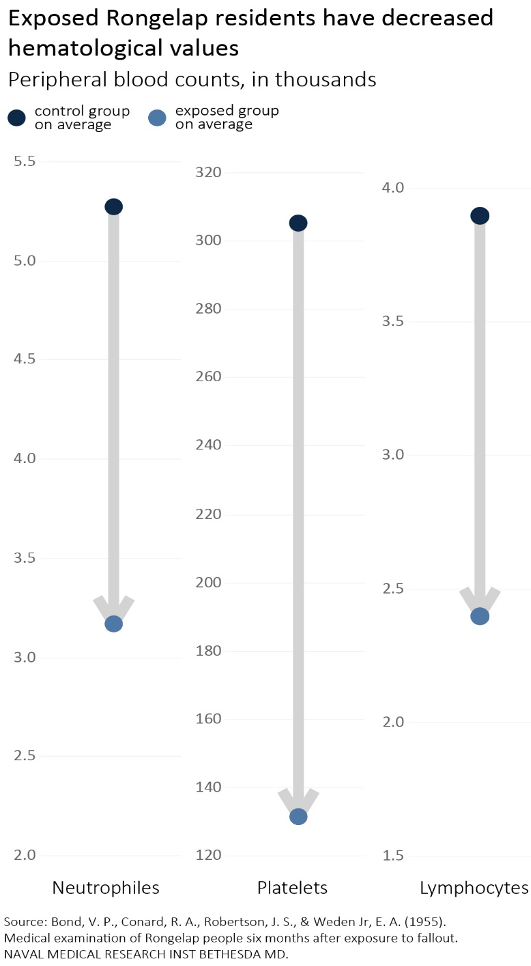From 1946 to 1958, the U.S. military conducted 67 nuclear weapon tests in the northern part of the Marshall Islands. Of these, 23 were conducted in the Bikini Atoll and 44 in or near the Enewetak Atoll. Prior to the tests, people living on these islands moved to other islands to avoid nuclear exposure. For example, the Bikini community was relocated to Kili Island and the Enewetak community to Ujelang Atoll. However, the residents of Rongelap Island, 100 miles east of Bikini Atoll, did not receive the same information as the Bikini community and many remained on the island at the time of the 1954 Castle Bravo test, which produced the highest yield (equivalent to the explosive energy of 15,000,000 metric tons of TNT) of the 67 nuclear tests.
These tests largely affected the health of people on Rongelap Island. When researchers assessed the effect of nuclear tests on newborns in 2010, they found that in 1954, a baby born in Rongelap Atoll would absorb considerably higher radiation doses than a baby born in Majuro Atoll, far from the test sites, the same year. The amount of radiation is calculated in four tissues and organs: colon, red bone marrow, stomach, and thyroid. The graphic below shows that thyroid absorbs the largest amount of radiation doses compared to the other three tissues and organs. This could also explain the high prevalence of thyroid cancer in the Rongelap community.

Evidence also comes from a medical examination of Rongelap residents after exposure to the fallout of the Bravo test. As the graphic below shows, compared with the control group, which was not exposed to nuclear radiation, exposed people suffered from a significant decrease of neutrophils, platelets, and lymphocytes, which is a sign of hematological toxicity resulting from penetrating gamma radiation. This decrease in blood cells may lead to infection, bleeding, or anemia.
 Some Rongelap residents claim they were intentionally not informed because the U.S. military wanted to use them as human guinea pigs for radiation research. The military maintains it miscalculated the yield of the Castle Bravo test, and according to its original calculation, the test would not affect people living in Rongelap.
Some Rongelap residents claim they were intentionally not informed because the U.S. military wanted to use them as human guinea pigs for radiation research. The military maintains it miscalculated the yield of the Castle Bravo test, and according to its original calculation, the test would not affect people living in Rongelap.
At any rate, it is certain that people in Rongelap suffered deeply from nuclear exposure. And although the Bikini and Enewetak communities were not exposed to radioactive fallout because of their relocations, they might never have the chance to move back to their home islands. Even if all the radioactive waste would be cleaned up someday in the future, many of the islands were completely destroyed by large craters that cannot be refilled.
The 1996 Comprehensive Nuclear-Test-Ban Treaty has banned all nuclear explosions on earth. This measure may help ensure the tragedy of the Marshall Islands does not happen again.
